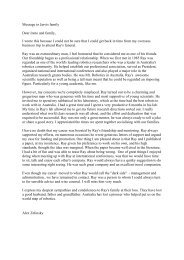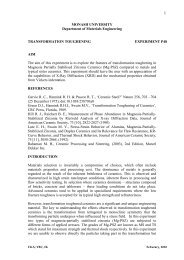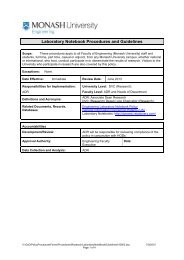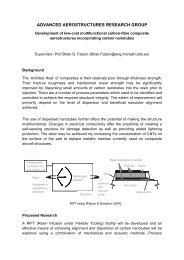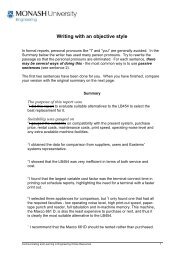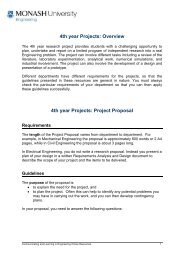Giving Oral Presentations.pdf
Giving Oral Presentations.pdf
Giving Oral Presentations.pdf
Create successful ePaper yourself
Turn your PDF publications into a flip-book with our unique Google optimized e-Paper software.
Devising and <strong>Giving</strong> <strong>Oral</strong> <strong>Presentations</strong>In many units in Engineering, you have to report work in oral presentations. You mayhave to present a proposal for a design, a progress report of an on-goinginvestigation or the final outcomes of a project. When you are working in a group, thepresentation will then be a group presentation where a number of the groupmembers, if not all, present different aspects of the work.There are significant differences between a report of your work in an oralpresentation and in a written report. An oral presentation involves face-to-face, moreinformal spoken communication where you only have time to inform the audience ofthe key aspects of your work. Do not take an oral presentation word for word from awritten report!The purpose of an oral presentation is to• report key information about a technical project• use spoken delivery techniques and visual aids to enhancecommunicationKeep this purpose in mind as you select information to include in your presentation.The audience is often a client, for example, if you are presenting a bridge designyour audience might be the shire engineer and the local council. You want to conveyyour enthusiasm, your technical expertise and your professional judgement to themKeep this audience in mind as you decide what to include in your presentation.The key features of a good presentation are:1. a clear logical structure2. effective visual aids, and3. good delivery techniques.1. Clear, logical structureYou need to plan any oral presentation very carefully so that the information is easyfor the audience to understand and to remember.In the introduction, make sure that• you give a clear statement of the purpose of the presentation• you provides an overview of the key aspects of your investigation• you outline the main sections of the presentation• you introduce each member of the team and outline the material that they willbe covering.Communicating and Learning in Engineering Online Resources 1
3. Delivery techniquesTry to present with a natural conversational style. You want your presentation to beinteresting, convincing and professional, and you want to share your enthusiasm foryour subject with the audience.Key aspects of delivery for each speaker:• Voice: Keep your voice enthusiastic, loud enough and not too fast.• Eye contact: Keep eye contact with the audience.• Stance: Have a relaxed, natural stance.• Using notes: Do not read notes or your report word for word. Just use keywords and phrases as prompts.• Using slides: Make sure you explain the information on each slide.Question and answer time:There will be a few minutes at the end of each presentation for questions about yourdesigns. Anticipate these questions and prepare answers to them.4. Assessment CriteriaThe following aspects are always considered in the assessment of an oralpresentation:1. Content• technically accurate• logically organised with clear structure announced by first speaker and inlinks between speakers2. Slides• easy to read with clearly labelled diagrams3. Voice• easy to hear, confident and enthusiastic4. Questions• answered thoughtfully and accuratelyCommunicating and Learning in Engineering Online Resources 4
5. Good References for oral presentationsMablekos, C.M. (1991) <strong>Presentations</strong> That Work IEEE, New York.Hargrave-Andrews Library 808.51 M112PMandel, S. (1988) Technical Presentation Skills Crisp Publications, Menlo Park.Hargrave-Andrews Library 808.51 M271T.cFor further assistance with oral presentations:Online tutorial on <strong>Oral</strong> <strong>Presentations</strong> athttp://www.monash.edu.au/lls/llonline/speaking/presentations/index.xmlCommunicating and Learning in Engineering Online Resources 5



